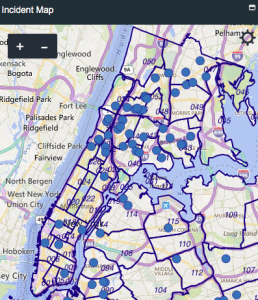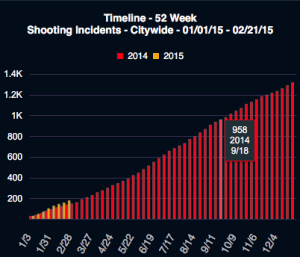NYPD Launches Compstat 2.0 Portal With Rough Edges, No Bulk Download

The NYPD’s CompStat 2.0 portal launched last week, with Police Commissioner Bill Bratton noting that “CompStat 2.0 has the ability to take … all the information, with few exceptions, that’s shared with our police officers, and now share it with both you, the media, and to the public, more importantly.”
However, that’s not the case. The new portal is basically a new layer of paint over the same limited subset of CompStat data that the NYPD has shared with the public for years. The most notable improvement in CompStat 2.0 is an interactive map of each incident in the CompStat reports, mapped to the nearest intersection. This is a modest step forward for open police data, and rescues a web site that is otherwise a web-based spreadsheet viewer.
The CompStat incident map is fatally flawed, because the actual location data of all incident is locked away from the public. The NYPD has shown us that there is a latitude and longitude associated with each incident, but won’t make it available to download at all. The only way to see the location of each CompStat incident is to click on each dot on the map in turn. Unfortunately, each incident type is the same color, and the map frequently zooms out during routine browsing, making it tedious to examine different incidents in the same precinct. Compare this data release to the Vision Zero map, which provides downloads of more than twenty data sets.

In addition to the map, CompStat 2.0 has the same problems that CompStat 1.0 had. There is no historical CompStat data made available, only the availability to see data for the last 7 days, the last 28 days, or the year to date. Every week, the NYPD publishes a new snapshot of CompStat data, and discards the previous week’s data. It is unclear why CompStat cannot provide last week’s snapshot as well as this week’s snapshot, to perform a week-by-week analysis of CompStat data. Again, CompStat 2.0 offers a glimpse of this data: the portal can chart the number of incidents on a weekly basis, so this information is clearly available somewhere. The fact that there’s no way to download it in bulk is baffling.
CompStat 2.0 also does not allow users to compare to one precinct’s incidents to another’s, or to compare one month of incidents to another, and so on. Compared to a web site like NY Open Government—which allows users to search, sort, and download data in bulk—CompStat 2.0 has a long way to go.
Reinvent Albany would argue that providing CompStat data (a step NYPD took in June 2015) as machine-readable files was a far more meaningful step in opening police data than launching this portal without a download button.
